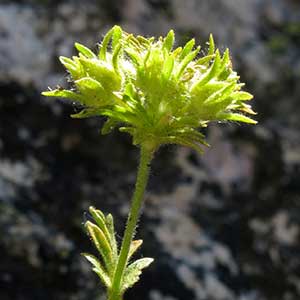Ivesia longibracteata
Ivesia sabulosa
Castle Crags ivesia, longbract mousetail
intermountain ivesia, intermountain mousetail, Sevier ivesia, yellow comarella
ascending to erect, 0.3–1.2 dm.
ascending to erect, (1.8–)2–6(–6.5) dm.
weakly planar to loosely ± cylindric, (0.5–)2–4(–6) cm; sheathing base glandular abaxially, otherwise glabrous;
petiole 0.5–2 cm, hairs 0.2–1 mm;
leaflets 5–6 per side, 2–6 mm, ± short-hirsute, glandular-puberulent, lobes 2–7, oblanceolate to spatulate or obovate, apex not setose.
7–25(–30) cm; sheathing base usually sparsely strigose abaxially;
petiole 1–4(–5) cm;
leaflets 15–40 per side, ± flabellate, 3–14 mm, usually incised to base into 2–3 oblanceolate lobes, ± densely short-hirsute to -villous.
1–3, not paired.
3–14-flowered, 1–2.5 cm diam.;
glomerules 1.
10–60-flowered, 4–15 cm diam.
1.5–6 mm.
(1–)5–20 mm.
8–10 mm diam.;
epicalyx bractlets linear to narrowly lanceolate or elliptic, 2.5–5 mm, longer than sepals;
hypanthium shallowly cupulate, 0.5–1 × 2–3 mm;
sepals 1.5–2.5 mm, ± acute;
petals pale yellow, linear to narrowly oblanceolate, 1.5–2.5 mm;
stamens 5, filaments 0.7–1.3 mm, anthers yellow, 0.5–0.8 mm;
carpels 6–11, styles 1–1.5 mm.
9–14 mm diam.;
epicalyx bractlets lanceolate, 1–3(–3.3) mm;
hypanthium interior golden, 1–2 × 3–5 mm;
sepals (2.5–)3.5–6 mm, base golden adaxially, apex acute to acuminate;
petals yellow, linear to narrowly oblanceolate, 2–4 mm;
stamens 5, filaments 2–4 mm, anthers yellow, sometimes red-rimmed, oblong, 0.6–1.2 mm;
carpels 1–5, styles 2–3 mm.
cream to light tan, 1.2–1.5 mm.
brown, 1.7–2.2 mm.
Ivesia longibracteata
Ivesia sabulosa
Of conservation concern.
Ivesia longibracteata is known only from the Castle Crags area of Shasta County. The epithet alludes to a diagnostic characteristic unique in the genus: the epicalyx bractlets are longer than the sepals. The plants grow on vertical rock faces, a habitat more characteristic of sect. Setosae; however, the stems are ascending to erect and do not form hanging clumps, and the pedicels are not curved in fruit.
(Discussion copyrighted by Flora of North America; reprinted with permission.)
Of conservation concern.
Ivesia sabulosa occurs from central Nevada and southwestern Utah south to Arizona north of the Grand Canyon.
(Discussion copyrighted by Flora of North America; reprinted with permission.)


